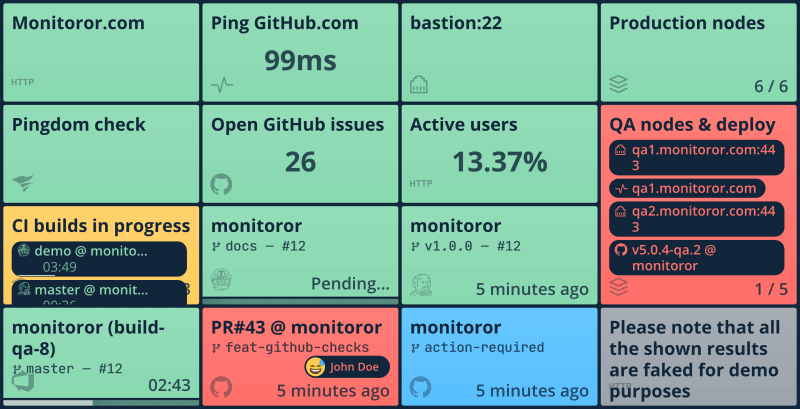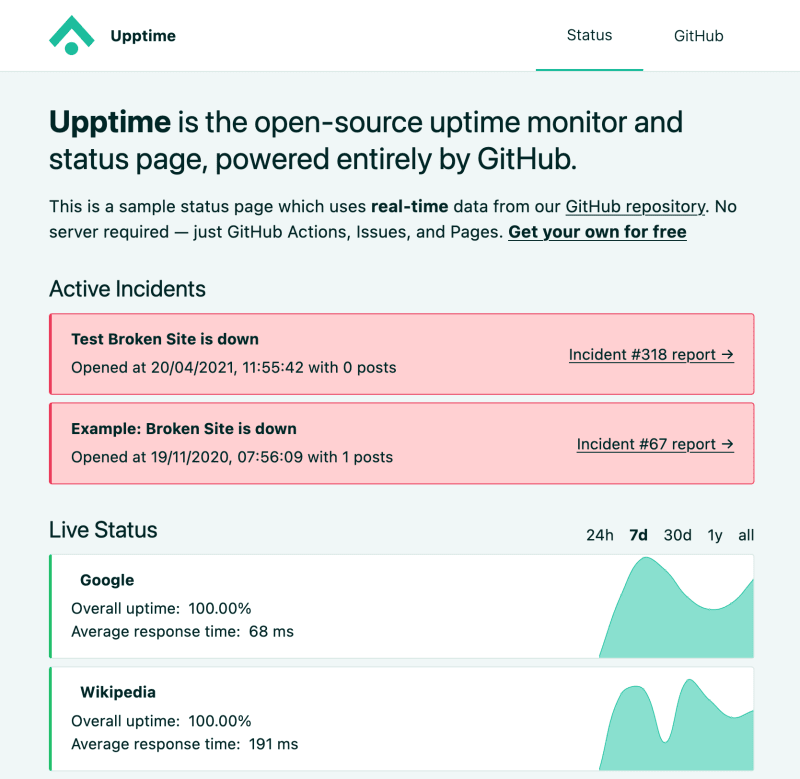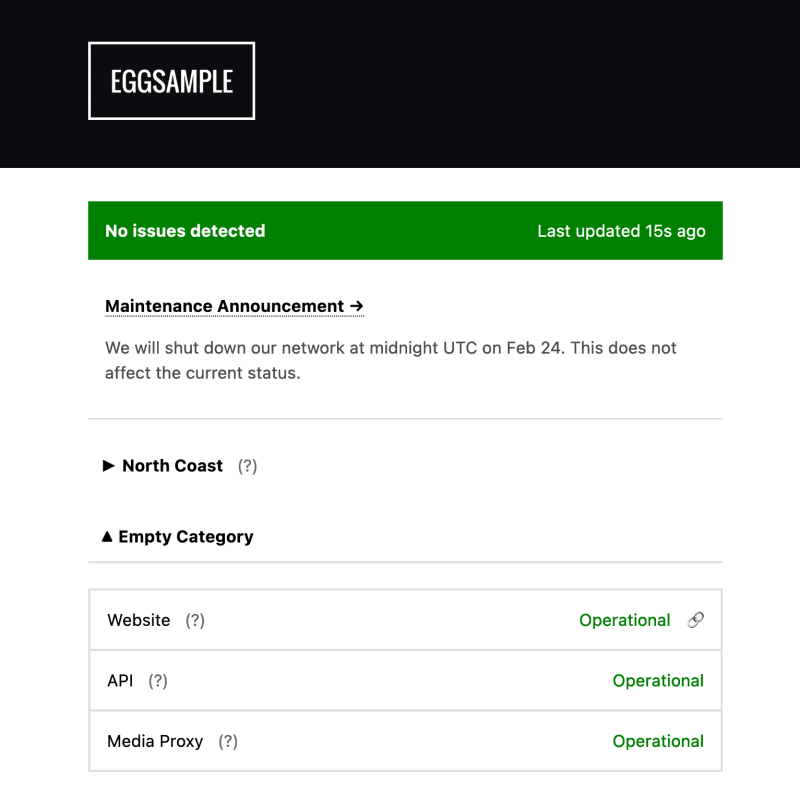With so much reliance on online services and applications these days, a status page is essential to a business, its support and IT teams. It’s a key component in your incident communication strategy.
Communicating the status of your website or service to users (particularly customers) creates trust and keeps them updated—especially during downtimes. Plus, it saves you from sending out emails or using other time-consuming methods to provide status updates.
There are two ways to go around setting up your own status page, using a SAAS solution or self-hosting your status page. Now you might be wondering, what are the advantages and disadvantages of self-hosted vs hosted status pages? We go into detail about this in our blog post Hosted vs self-hosted for your Status Page, Which is best?.
However, in this blog post we want to provide you with some great open source alternatives for self-hosted status pages, ranked from good to the best.
Best 6 Open Source Status Pages 2022
To summarize, a status page should be able to provide a clear picture of the current and past status of your application or service, ideally with monitoring and incident automation and history. The following open source alternatives cover these key features:
- Monitoror
- Statping
- Vigil
- Upptime
- CState
- Cachet
1. Monitoror
If you’re looking for a minimalistic and cool-looking status dashboard that automatically monitors the status of your services, then Monitoror is just for you.
Monitoror installs as a single installer file on your Mac, Windows or Linux and is literally ready to go. However, if you require incident reporting and history you might want to look into our next candidates.
Features of Monitoror
- Monitoring
- Geeky design
- Single file running on Windows, Mac, Linux
2. Statping
Statping also has powerful monitoring capabilities, and allows you to display beautiful metrics from your services.
Reporting your own incidents is also possible, but only via Statpin's own API. Nevertheless, with a little familiarization, this should be possible without any problems.
Statping is a bit more complex to set up and you need your own server to get the service running. However, it is also multi-platform so you can deploy it in any operating system.
Features of Statping
- Cool UI
- Mobile app
- Runs on any server
- Custom SASS styling
- Notification via different services
3. Vigil
A somewhat simpler service is Vigil. The program can do everything that a status page should be able to do - incident creation, monitoring and notification via plenty of channels (e.g. Email, SMS, Slack, Telegram).
Vigil is another service that requires self-hosting. An interesting fact is that Vigil is writing in Rust, so you’ll need either cargo or OPTopt to use the dockerized version.
A great advantage of Vigil is that it can be used internally on a company lan network. For a small company certainly a good and free service for internal use.
Features of Vigil
- Generates status page
- Notifications (Email, SMS, Slack, Telegram, and many more)
- Vigil local can be internally used (e.g. LAN)
4. Upptime
Upptime is one of our absolute favorites. The service is completely open source and very user-friendly. You don't need your own server since the status page is hosted directly via Github Services.
For a free status page, Upptime can do a lot: Incident creation, monitoring service, display of active and past incidents, live status and scheduled maintenances.
If one of your systems should crash, you can set up notifications via different external providers.
Best of all, Upptime creates an automatic Github issue for incidents and also closes it again as soon as the incident is resolved. This way, the developer team can always keep an eye on your services.
Features of Upptime
- Opens and closes a github issue automatically(good for dev team)
- Commits for response time
- No server required, powered entirely by github
- Active incidents, scheduled maintenance, live status, past incidents
- Notifications to different services
- Handy UI
5. CState
CState is another minimalist option, interestingly based on Hugo (static site generator). Thanks to that, it can be easily hosted via various providers such as Github or Netlify and runs extremely fast due to the static structure of the site.
CState provides all the most important features a status page should have, namely incident and maintenance reporting and history.
Individual customizations are also feasible. In addition, a built-in package with translations into eight different languages, including Spanish, Portuguese, Turkish and Dutch, is included. In case of complications, a limited support helps you for a small fee- or even with the installation.
Features of CState
- Hugo based
- Hosted on netlify, github pages
- Maintenance, incident creation
- Fast, static site
- Custom design possible
- Comes with build in translation into 8 languages
6. Cachet
This brings us to the old hand and top dog among the free status sites: Cachet.
The first thing that stands out is that Cachet is big. The open source project has many contributors, extensive documentation and even its own Slack community, which is always happy to help with questions.
You will however need to configure and maintain a server with Cachet and is slightly less straightforward than some previously mentioned alternatives.
Other than that, the user interface is a delight and the dashboard is clearly laid out. You can create incidents, monitoring services, scheduled maintenances as well as your own metrics. Furthermore you can add subscribers and team members with different rights. Cachet provides two-factor authentication for this purpose.
The customizable status page is also particularly convenient for your users. The powerful JSON API pleasantly completes the picture.
Features of Cachet
- Incident, maintenance, monitoring metrics
- Subscribers & team members
- Nice and easy to use dashboard
- Two factor authentication
- Customizable status page
- Powerful JSON API
- Extensive documentation
Conclusion
If you’d prefer not to have to configure and maintain a new server, and don’t mind relaying in a service like Github or Netlify, Upptime and CState are a great choice.
However if a simple monitoring service and slick status dashboard is what you’re after, Monitoror with its geeky design is probably the best option for you.
Now, if you don’t mind the extra effort of setting up and maintaining your own server, and want a more powerful alternative to the above, then you can’t go wrong with Cachet, Statping or Vigil. Especially Cachet stands out with its long history, many contributors and its excellent and comprehensive documentation.
Finally, if you find yourself outgrowing these free and open source alternatives, it might be time for you to consider a modern SaaS solution, like Statuspal, where you’ll get all of the features described above and then some, bundled with amazing and responsive support that can help you get up and running in a few minutes.









Top comments (0)